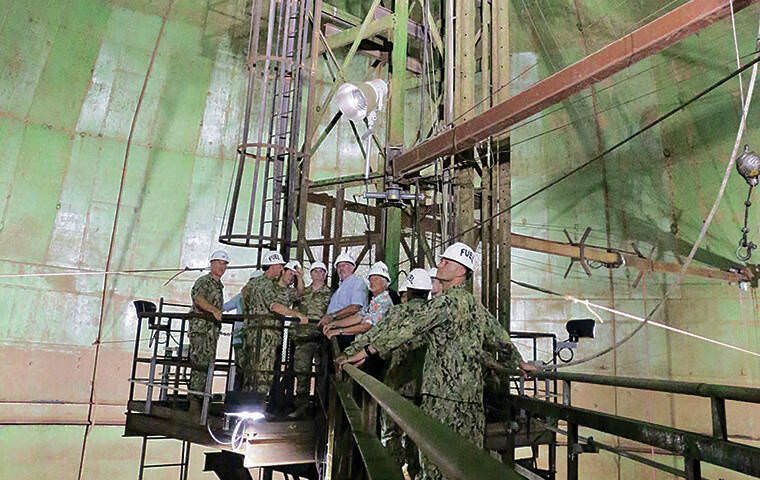Hung Cao – A Navy Diver In The Pentagon Briefing Room
Hung Cao and the Fight to Rebuild America’s Maritime Power Before the Next War Arrives by Captain John Konrad (gCaptain) The first thing you notice about the US Navy’s Undersecretary...

by John Konrad (gCaptain) Today US secretary of Defense Lloyd J. Austin announced the closure of the Red Hill fuel storage depot in Hawaii, which is the world’s largest underground fuel and ship bunker storage facility.
Unlike any other facility in the United States, Red Hill can store up to 250 million gallons of fuel. It consists of 20 steel-lined underground storage tanks encased in concrete, and built into cavities that were mined inside of Red Hill. Each tank has a storage capacity of approximately 12.5 million gallons.
Before the United States entered World War II, Franklin Roosevelt became concerned about the vulnerability of the many above-ground fuel storage tanks at Pearl Harbor. In 1940 it decided to build a new underground facility that would store more fuel and be safe from an enemy aerial attack. The Japanese attack on Pearl Harbor took place during the construction of Red Hill. As a result, a portion of the site was used to bury a large number of the fatalities. Those not claimed by families were moved to the National Memorial Cemetery of the Pacific when it opened after the war.
Because the Pacific Ocean is the largest in the world many naval experts considered this depot critical to fighting a war in Asia and, in 2013 contractors completed a three-year overhaul of the facility’s tanks but, in 2014, the newly repaired tanks leaked and 27,000 gallons of jet fue wasl lost somewhere underground.
In December of last year, residents of nearby military housing units began complaining about foul-smelling tap water bearing an oily sheen, as well as symptoms such as nausea, diarrhea, and intense headaches. In December 2021, more than 1,000 military families stationed in Hawaii had been forced from their homes after apparent jet fuel contamination in the water supply at Joint Base Pearl Harbor–Hickam.
“After close consultation with senior civilian and military leaders, I have decided to de-fuel and permanently close the Red Hill bulk fuel storage facility in Hawaii,” Austin said in a press statement today. “Centrally-located bulk fuel storage of this magnitude likely made sense in 1943, when Red Hill was built. And Red Hill has served our armed forces well for many decades. But it makes a lot less sense now. The distributed and dynamic nature of our force posture in the Indo-Pacific, the sophisticated threats we face, and the technology available to us demand an equally advanced and resilient fueling capability. To a large degree, we already avail ourselves of dispersed fueling at sea and ashore, permanent and rotational. We will now expand and accelerate that strategic distribution.”
A Pentagon spokesman provided an even less helpful statement saying the Navy will replace the tanks with a plan to send fuel to ships via “dispersal at sea.”
US Merchant Marine experts say this decision doesn’t take into account the age and status of the United State’s Military Sealift Command tanker fleet, which are the ships responsible for at-sea refueling of both ships and aircraft. Shipbuilding experts find it very unlikely that Austin will be able to find the funding or the shipyards need to build a fleet of merchant tankers with “equally advanced and resilient fueling capability.”
During the Trump Administration, US Maritime Administrator Rear Admiral Mark Buzby warned Congress repeatedly that the US Merchant Marine did not have enough tankers or qualified merchant mariners to fight even a limited war. In response, Congress passed an emergency measure in 2021 called the U.S. Tanker Security Program. In this bill, the United States pays both private companies like Maersk a stipend to reflag their tankers American.
“The tanker security measure was an emergency stop-gap measure,” said one MARAD official gCaptain interviewed. “It barely meets the most basic needs of our military and in no way can replace the capabilities at Red Hill. The Secretary of Defense is either completely misinformed or delusional if he thinks otherwise.”
It is not just US Navy and MARAD officials who have warned about serious tanker shortages. In 2020 Leutenant. General John Broadmeadow, while serving last year as deputy commander of the U.S. Transportation Command, told Congress “a 10-tanker program will be a welcome start to begin to address the gap in U.S. Flagged bulk fuel delivery. ”
The Secretary’s memorandum can be found here; the Fact Sheet can be found here.

Sign up for gCaptain’s newsletter and never miss an update

Subscribe to gCaptain Daily and stay informed with the latest global maritime and offshore news
Essential news coupled with the finest maritime content sourced from across the globe.
Sign Up